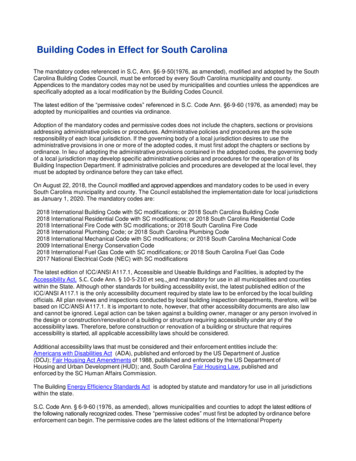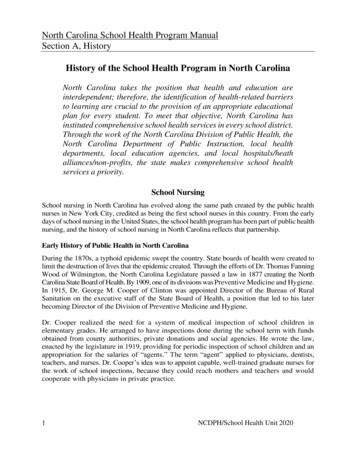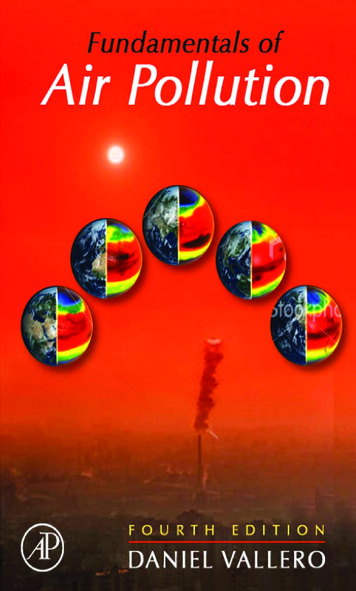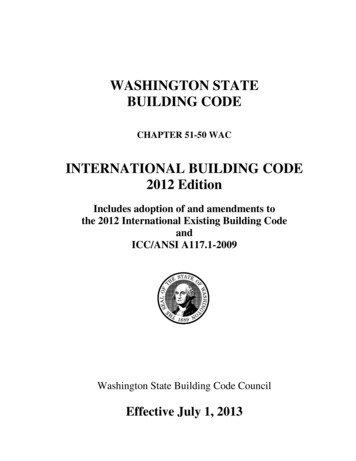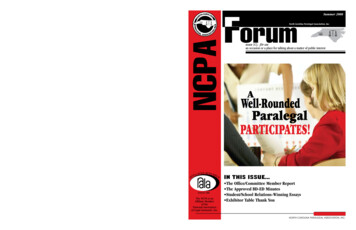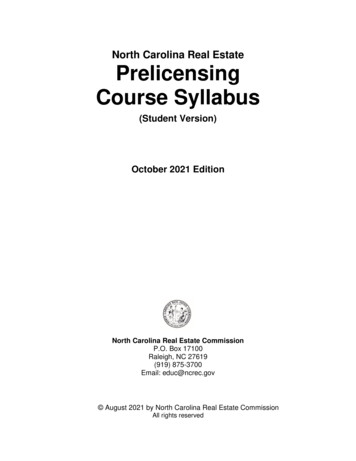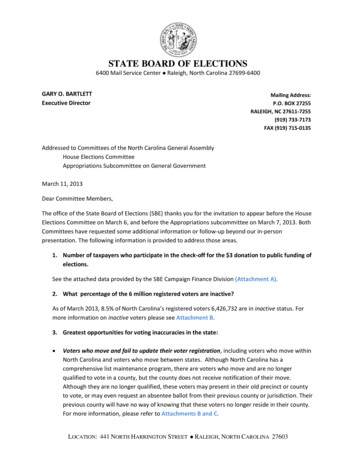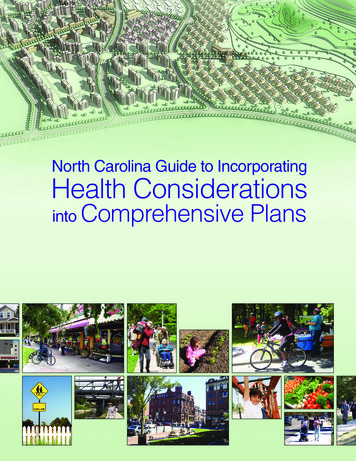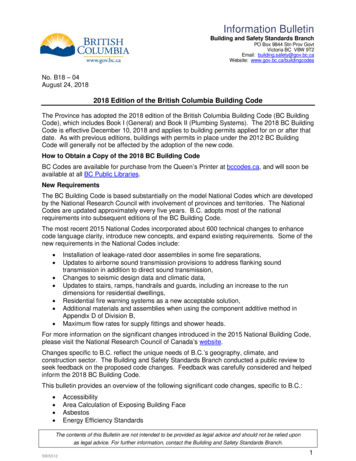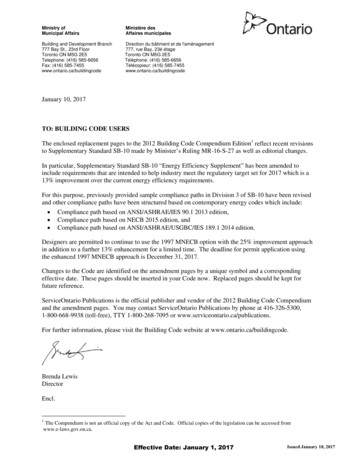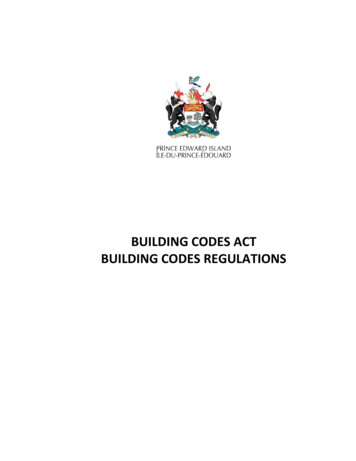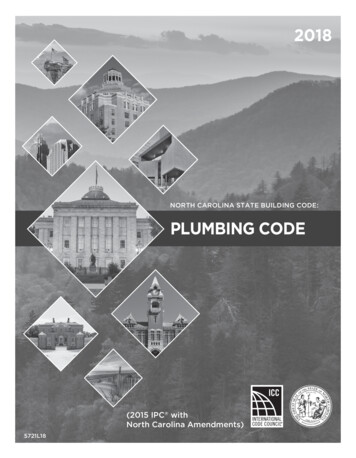
Transcription
2018NORTH CAROLINA STATE BUILDING CODE:PLUMBING CODE(2015 IPC withNorth Carolina Amendments)5721L18
2018 North Carolina Plumbing CodeFirst Printing: May 2018ISBN: 978-1-60983-832-4COPYRIGHT 2018byINTERNATIONAL CODE COUNCIL, INC.ALL RIGHTS RESERVED. This 2018 North Carolina Plumbing Code contains substantial copyrighted material from the 2015International Plumbing Code , third printing, which is a copyrighted work owned by the International Code Council, Inc. Without advance written permission from the copyright owner, no part of this book may be reproduced, distributed or transmitted inany form or by any means, including, without limitation, electronic, optical or mechanical means (by way of example, and notlimitation, photocopying or recording by or in an information storage retrieval system). For information on use rights and permissions, please contact: ICC Publications, 4051 Flossmoor Road, Country Club Hills, IL 60478. Phone 1-888-ICC-SAFE (4227233).Trademarks: “International Code Council,” the “International Code Council” logo, “ICC,” the “ICC” logo, “InternationalPlumbing Code,” “IPC” and other names and trademarks appearing in this book are trademarks of the International Code Council, Inc., and/or its licensors (as applicable), and may not be used without permission.Cover photo courtesy of Jeffrey Clare.PRINTED IN THE U.S.A.T022620
NORTH CAROLINA STATE BUILDING CODE COUNCILDECEMBER 12, 2017www.ncbuildingcodes.comCHAIRVICE CHAIRCharles Conner, RA — 22(Architect)Hager Smith Design300 South Dawson StreetRaleigh, NC 27601919-838-5104Robbie Davis — 21(General Contractor)Turn-Key Contractors5998 Dortches BoulevardRocky Mount, NC 27804252-977-6680Daniel Priest, RA — 22(Architect)Priest ArchitecturePO Box 5295Charlotte, NC 28299704-379-1810Gary Embler — 23(Home Builder)Niblock Homes759 Concord Pkwy N, Ste. 20Concord, NC 28057704-361-7720Bridget Herring — 23(Public Representative)Energy Program CoordinatorPO Box 7148Asheville, NC 28802828-484-4852Tony Sears — 22(Municipal Representative)KinstonPO Drawer 339Kinston, NC 28502252-939-3111Ralph Euchner — 19(Gas Industry)PSNC EnergyPO Box 1398Gastonia, NC 28053704-810-3331Steve Knight, PE — 21(Structural Engineer)Steve L. Knight, PE1507 Mount Vernon Ave.Statesville, NC 28677704-878-2996Leon Skinner — 21(Building Inspector)Raleigh1 Exchange Plaza, Ste. 500Raleigh, NC 27601919-996-2455Keith Hamilton — 19(Mechanical Contractor)Element Service Group7414 Almaden WayCary, NC 27518919-926-1475Frankie Meads — 22(County Representative)Albemarle Home Builders200 Bayshore DriveElizabeth City, NC 27909252-330-2423David Smith — 22(Coastal Contractor)D. Smith Builder905 Saltwood LaneWilmington, NC 28411910-681-0394Wayne Hamilton — 21(Fire Services)Buncombe County270 Upper Herron Cove RoadWeaverville, NC 28787828-658-3911Robert Morrow — 19(Electrical Contractor)Electrical ContractorPO Box 1121Pilot Mountain, NC 27041336-420-7231Eric Tjalma, RA — 23(State Agency)State Construction301 North Wilmington St.Raleigh, NC 27601919-807-4097Keith Rogers, PE — 21(Mechanical Engineer)Bass, Nixon and Kennedy6310 Chapel Hill Road, Ste. 250Raleigh, NC 27612919-851-4422Wade White, PE — 19(Electrical Engineer)Brite Engineering2001 Old Westfield RoadPilot Mountain, NC 27041336-351-37812018 NORTH CAROLINA PLUMBING CODEiii
NORTH CAROLINADEPARTMENT OF INSURANCEwww.ncdoi.com/osfm919-647-0000By Statute, the Commissioner of Insurance has general supervision of the administration and enforcement of the North CarolinaState Building Code and the Engineering Division serves as the Staff for the Building Code Council. Officials of the Departmentof Insurance are:MIKE CAUSEYCommissionerBRIAN TAYLORSenior Deputy CommissionerCLIFF ISAAC, PEDeputy CommissionerBARRY GUPTON, PEChief Code ConsultantBILL MOELLER, PEChief Plumbing Code ConsultantCOMMITTEES OF THE COUNCILDECEMBER 12, 2017ivADMINISTRATIONENERGYMECHANICALRobbie Davis — ChairDaniel Priest, RA - Vice ChairRalph EuchnerWayne HamiltonSteve Knight, PEKeith Rogers, PELeon SkinnerDavid SmithWade White, PERalph Euchner — ChairCharles Conner, RASteve Knight, PEFrankie MeadsBridget HerringTony SearsDavid SmithEric Tjalma, RAKeith Rogers, PE — ChairRalph EuchnerKeith HamiltonBridget HerringRobert MorrowDavid SmithEric Tjalma, RAWade White, PEBUILDINGEXISTING BUILDINGRESIDENTIALDaniel Priest, RA — ChairCharles Conner, RAWayne HamiltonSteve Knight, PETony SearsLeon SkinnerEric Tjalma, RALeon Skinner — ChairKeith HamiltonWayne HamiltonSteve Knight, PERobert MorrowDaniel Priest, RAWade White, PEDavid Smith — ChairCharles Conner, RARalph EuchnerKeith HamiltonSteve Knight, PEFrankie MeadsRobert MorrowLeon SkinnerELECTRICALFIRE PREVENTIONSTRUCTURALWade White, PE — ChairRalph EuchnerBridget HerringRobert MorrowDaniel Priest, RAKeith Rogers, PEWayne Hamilton — ChairCharles Conner, RARalph EuchnerDaniel Priest, RALeon SkinnerWade White, PESteve Knight, PE — ChairFrankie MeadsDaniel Priest, RAKeith Rogers, PETony SearsLeon SkinnerEric Tjalma, RA2018 NORTH CAROLINA PLUMBING CODE
ACKNOWLEDGEMENTSNorth Carolina Building Code CouncilPlumbing Ad-Hoc CommitteeCHAIRKeith Rogers, PEBass, Nixon and Kennedy6310 Chapel Hill Road, Ste. 250Raleigh, NC 27612Al Bass, Jr., PEBass, Nixon and Kennedy6425 Chapman CourtRaleigh, NC 27612Elbert Hill, JrAmerican Plumbing3716 Auburn Church RoadGarner, NC 27529Jim LawsonCity of High Point211 South Hamilton StreetHigh Point, NC 27261Bill Moeller, PENC Department of InsuranceAlbemarle BuldingRaleigh, NC 27603Paula StricklandWilliams PH&AC1051 Grecade StreetGreensboro, NC 27408Ken KeplarWake County336 Fayetteville StreetRaleigh, NC 276012018 NORTH CAROLINA PLUMBING CODEv
vi2018 NORTH CAROLINA PLUMBING CODE
PREFACEIntroductionInternationally, code officials recognize the need for a modern, up-to-date plumbing code addressing the design and installation of plumbing systems through requirements emphasizing performance. The International Plumbing Code , in this 2015 edition, is designed to meet these needsthrough model code regulations that safeguard the public health and safety in all communities,large and small.This comprehensive plumbing code establishes minimum regulations for plumbing systemsusing prescriptive and performance-related provisions. It is founded on broad-based principles thatmake possible the use of new materials and new plumbing designs. This 2015 edition is fully compatible with all of the International Codes (I-Codes ) published by the International Code Council(ICC) , including the International Building Code , International Energy Conservation Code , International Existing Building Code , International Fire Code , International Fuel Gas Code , International Mechanical Code , ICC Performance Code , International Private Sewage Disposal Code ,International Property Maintenance Code , International Residential Code , International Wildland-Urban Interface Code and International Zoning Code .The International Plumbing Code provisions provide many benefits, among which is the modelcode development process that offers an international forum for plumbing professionals to discussperformance and prescriptive code requirements. This forum provides an excellent arena to debateproposed revisions. This model code also encourages international consistency in the application ofprovisions.DevelopmentThe first edition of the International Plumbing Code (1995) was the culmination of an effort initiatedin 1994 by a development committee appointed by the ICC and consisting of representatives of thethree statutory members of the International Code Council at that time, including: Building Officialsand Code Administrators International, Inc. (BOCA), International Conference of Building Officials(ICBO) and Southern Building Code Congress International (SBCCI). The intent was to draft a comprehensive set of regulations for plumbing systems consistent with and inclusive of the scope of theexisting model codes. Technical content of the latest model codes promulgated by BOCA, ICBO andSBCCI was utilized as the basis for the development. This 2015 edition presents the code as originally issued, with changes as reflected in the subsequent editions through 2012 and with changesapproved through the ICC Code Development Process through 2013 (completion of Group B). A newedition such as this is promulgated every 3 years.This code is founded on principles intended to establish provisions consistent with the scope of aplumbing code that adequately protects public health, safety and welfare; provisions that do notunnecessarily increase construction costs; provisions that do not restrict the use of new materials,products or methods of construction; and provisions that do not give preferential treatment to particular types or classes of materials, products or methods of construction.AdoptionThe International Code Council maintains a copyright in all of its codes and standards. Maintainingcopyright allows ICC to fund its mission through sales of books, in both print and electronic formats.The International Plumbing Code is designed for adoption and use by jurisdictions that recognizeand acknowledge the ICC’s copyright in the code, and further acknowledge the substantial sharedvalue of the public/private partnership for code development between jurisdictions and the ICC.The ICC also recognizes the need for jurisdictions to make laws available to the public. All ICCcodes and ICC standards, along with the laws of many jurisdictions, are available for free in a nondownloadable form on the ICC’s website. Jurisdictions should contact the ICC at adoptions@iccsafe.org to learn how to adopt and distribute laws based on the International PlumbingCode in a manner that provides necessary access, while maintaining the ICC’s copyright.2018 NORTH CAROLINA PLUMBING CODEvii
MaintenanceThe International Plumbing Code is kept up to date through the review of proposed changes submitted by code enforcing officials, industry representatives, design professionals and other interestedparties. Proposed changes are carefully considered through an open code development process inwhich all interested and affected parties may participate.The contents of this work are subject to change through both the Code Development Cycles andthe governmental body that enacts the code into law. For more information regarding the codedevelopment process, contact the Codes and Standards Development Department of the International Code Council.While the development procedure of the International Plumbing Code ensures the highestdegree of care, the ICC, its members and those participating in the development of this code do notaccept any liability resulting from compliance or noncompliance with the provisions because the ICCdoes not have the power or authority to police or enforce compliance with the contents of thiscode. Only the governmental body that enacts the code into law has such authority.Code Development Committee Responsibilities(Letter Designations in Front of Section Numbers)In each code development cycle, proposed changes to the code are considered at the CommitteeAction Hearings by the International Plumbing Code Development Committee, whose action constitutes a recommendation to the voting membership for final action on the proposed change. Proposed changes to a code section that has a number beginning with a letter in brackets areconsidered by a different code development committee. For example, proposed changes to codesections that have [BS] in front of them (e.g., [BS] 309.2) are considered by the IBC – Structural CodeDevelopment Committee at the code development hearings.Marginal and Text MarkingsSolid vertical lines in the margins within the body of the code indicate a technical change from therequirements of the 2012 edition. Deletion indicators in the form of an arrow ( ) are provided inthe margin where an entire section, paragraph, exception or table has been deleted or an item in alist of items or a table has been deleted. Underlining within the body of the code indicate a technicalchange to the 2018 North Carolina Plumbing Code from the requirements of the 2015 edition of theInternational Plumbing Code.A single asterisk [*] placed in the margin indicates that text or a table has been relocated withinthe code. A double asterisk [**] placed in the margin indicates that the text or table immediatelyfollowing it has been relocated there from elsewhere in the code. The following table indicates suchrelocations in the 2015 edition of the International Plumbing Code.2015 LOCATION2012 LOCATIONAppendix CSection 716Appendix FAppendix CItalicized TermsSelected terms set forth in Chapter 2, Definitions, are italicized where they appear in code text.Such terms are not italicized where the definition set forth in Chapter 2 does not impart theintended meaning in the use of the term. The terms selected have definitions that the user shouldread carefully to facilitate better understanding of the code.viii2018 NORTH CAROLINA PLUMBING CODE
EFFECTIVE USE OF THE INTERNATIONAL PLUMBING CODEThe International Plumbing Code (IPC) is a model code that regulates the design and installation ofplumbing systems including the plumbing fixtures in all types of buildings except for detached oneand two-family dwellings and townhouses that are not more than three stories above grade inheight. The regulations for plumbing systems in one- and two-family dwellings and townhouses arecovered by Chapters 25 through 33 of the International Residential Code (IRC). The IPC addressesgeneral plumbing regulations, fixture requirements, water heater installations and systems forwater distribution, sanitary drainage, special wastes, venting, storm drainage and medical gases.The IPC does not address fuel gas piping systems as those systems are covered by the InternationalFuel Gas Code (IFGC). The IPC also does not regulate swimming pool piping systems, process pipingsystems, or utility-owned piping and systems. The purpose of the IPC is to the establish the minimum acceptable level of safety to protect life and property from the potential dangers associatedwith supplying potable water to plumbing fixtures and outlets and the conveyance of bacteria-ladenwaste water from fixtures.The IPC is primarily a specification-oriented (prescriptive) code with some performance-orientedtext. For example, Section 405.1 is a performance statement but Chapter 6 contains the prescriptiverequirements that will cause Section 405.1 to be satisfied.Where a building contains plumbing fixtures, those fixtures requiring water must be providedwith an adequate supply of water for proper operation. The number of required plumbing fixturesfor a building is specified by this code and is based upon the anticipated maximum number of occupants for the building and the type of building occupancy. This code provides prescriptive criteriafor sizing piping systems connected to those fixtures. Through the use of code-approved materialsand the installation requirements specified in this code, plumbing systems will perform theirintended function over the life of the building. In summary, the IPC sets forth the minimum requirements for providing safe water to a building as well as a safe manner in which liquid-borne wastesare carried away from a building.Arrangement and Format of the 2015 IPCThe format of the IPC allows each chapter to be devoted to a particular subject with the exceptionof Chapter 3 which contains general subject matters that are not extensive enough to warrant theirown independent chapter. The IPC is divided into 14 different parts:Chapters1-23456789101112131415Appendices A-E2018 NORTH CAROLINA PLUMBING CODESubjectsAdministration and DefinitionsGeneral RegulationsFixtures, Faucets and Fixture FittingsWater HeatersWater Supply and DistributionSanitary DrainageIndirect/Special WasteVentsTraps, Interceptors and SeparatorsStorm DrainageSpecial Piping (Medical Gas)Nonpotable Water SystemsSubsurface Landscape Irrigation SystemsReferenced StandardsAppendicesix
The following is a chapter-by-chapter synopsis of the scope and intent of the provisions of theInternational Plumbing Code:Chapter 1 Scope and Administration. This chapter contains provisions for the application,enforcement and administration of subsequent requirements of the code. In addition to establishing the scope of the code, Chapter 1 identifies which buildings and structures come under its purview. Chapter 1 is largely concerned with maintaining “due process of law” in enforcing therequirements contained in the body of this code. Only through careful observation of the administrative provisions can the code official reasonably expect to demonstrate that “equal protectionunder the law” has been provided.Chapter 2 Definitions. Chapter 2 is the repository of the definitions of terms used in the body ofthe code. Codes are technical documents and every word, term and punctuation mark can impactthe meaning of the code text and the intended results. The code often uses terms that have aunique meaning in the code and the code meaning can differ substantially from the ordinarilyunderstood meaning of the term as used outside of the code.The terms defined in Chapter 2 are deemed to be of prime importance in establishing the meaning and intent of the code text that uses the terms. The user of the code should be familiar with andconsult this chapter because the definitions are essential to the correct interpretation of the codeand because the user may not be aware that a term is defined.Where understanding of a term’s definition is especially key to or necessary for understanding ofa particular code provision, the term is shown in italics wherever it appears in the code. This is trueonly for those terms that have a meaning that is unique to the code. In other words, the generallyunderstood meaning of a term or phrase might not be sufficient or consistent with the meaning prescribed by the code; therefore, it is essential that the code-defined meaning be known.Guidance regarding tense, gender and plurality of defined terms as well as guidance regardingterms not defined in this code is provided.Chapter 3 General Regulations. The content of Chapter 3 is often referred to as “miscella-neous,” rather than general regulations. This is the only chapter in the code whose requirements donot interrelate. If a requirement cannot be located in another chapter, it should be located in thischapter. Chapter 3 contains safety requirements for the installation of plumbing and nonplumbingrequirements for all types of fixtures. This chapter also has requirements for the identification ofpipe, pipe fittings, traps, fixtures, materials and devices used in plumbing systems.The safety requirements of this chapter provide protection for the building’s structural members, as well as prevent undue stress and strain on pipes. The building’s structural stability is protected by the regulations for cutting and notching of structural members. Additional protection forthe building occupants includes requirements to maintain the plumbing in a safe and sanitary condition, as well as privacy for those occupants.Chapter 4 Fixtures, Faucets and Fixture Fittings. This chapter regulates the minimum num-ber of plumbing fixtures that must be provided for every type of building. This chapter also regulates the quality of fixtures and faucets by requiring those items to comply with nationallyrecognized standards. Because fixtures must be properly installed so that they are usable by theoccupants of the building, this chapter contains the requirements for the installation of fixtures.Because the requirements for the number of plumbing fixtures affects the design of a building,Chapter 29 of the International Building Code (IBC) includes, verbatim, many of the requirementslisted in Chapter 4 of this code.Chapter 5 Water Heaters. Chapter 5 regulates the design, approval and installation of waterheaters and related safety devices. The intent is to minimize the hazards associated with the installation and operation of water heaters. Although this code does not regulate the size of a waterheater, it does regulate all other aspects of the water heater installation such as temperature andpressure relief valves, safety drip pans, installation and connections. Where a water heater also supplies water for space heating, this chapter regulates the maximum water temperature supplied tothe water distribution system.x2018 NORTH CAROLINA PLUMBING CODE
Chapter 6 Water Supply and Distribution. This chapter regulates the supply of potable waterfrom both public and individual sources to every fixture and outlet so that it remains potable anduncontaminated. Chapter 6 also regulates the design of the water distribution system, which willallow fixtures to function properly and also help prevent backflow conditions. The unique requirements of the water supply for health care facilities are addressed separately. It is critical that thepotable water supply system remain free of actual or potential sanitary hazards by providing protection against backflow.Chapter 7 Sanitary Drainage. The purpose of Chapter 7 is to regulate the materials, design andinstallation of sanitary drainage piping systems as well as the connections made to the system. Theintent is to design and install sanitary drainage systems that will function reliably, that are neitherundersized nor oversized and that are constructed from materials, fittings and connections as prescribed herein. This chapter addresses the proper use of fittings for directing the flow into andwithin the sanitary drain piping system. Materials and provisions necessary for servicing the drainage system are also included in this chapter.Chapter 8 Indirect/Special Waste. This chapter regulates drainage installations that requirean indirect connection to the sanitary drainage system. Fixtures and plumbing appliances, such asthose associated with food preparation or handling, health care facilities and potable liquids, mustbe protected from contamination that can result from connection to the drainage system. An indirect connection prevents sewage from backing up into a fixture or appliance, thus providing protection against potential health hazards. The chapter also regulates special wastes containinghazardous chemicals. Special waste must be treated to prevent any damage to the sanitary drainagepiping and to protect the sewage treatment processes.Chapter 9 Vents. Chapter 9 covers the requirements for vents and venting. Knowing why ventingis required makes it easier to understand the intent of this chapter. Venting protects every trapagainst the loss of its seal. Provisions set forth in this chapter are geared toward limiting the pressure differentials in the drainage system to a maximum of 1 inch of water column (249 Pa) above orbelow atmospheric pressure (i.e., positive or negative pressures).Chapter 10 Traps, Interceptors and Separators. This chapter contains design requirementsand installation limitations for traps. Prohibited types of traps are specifically identified. Where fixtures do not frequently replenish the water in traps, a method is provided to ensure that the waterseal of the trap will be maintained. Requirements for the design and location of various types ofinterceptors and separators are provided. Specific venting requirements are given for separatorsand interceptors as those requirements are not addressed in Chapter 9.Chapter 11 Storm Drainage. Chapter 11 regulates the removal of storm water typically associ-ated with rainfall. The proper installation of a storm drainage system reduces the possibility ofstructural collapse of a flat roof, prevents the leakage of water through the roof, prevents damageto the footings and foundation of the building and prevents flooding of the lower levels of the building.Chapter 12 Special Piping and Storage Systems. Deleted.Chapter 13 Nonpotable Water Systems. This chapter regulates the design and installation ofnonpotable water systems. The reduction of the use of potable water in buildings has led to designers of buildings in some jurisdictions to use nonpotable water for irrigation and flushing of waterclosets and urinals. As such, this chapter provides the overall requirements for these systems.Chapter 14 Subsurface Landscape Irrigation Systems. Deleted.Chapter 15 Referenced Standards. Chapter 15 contains a comprehensive list of all standardsthat are referenced in the code. The standards are part of the code to the extent of the reference tothe standard. Compliance with the referenced standard is necessary for compliance with this code.By providing specifically adopted standards, the construction and installation requirements necessary for compliance with the code can be readily determined. The basis for code compliance is,therefore, established and available on an equal basis to the code official, contractor, designer andowner.2018 NORTH CAROLINA PLUMBING CODExi
Chapter 15 is organized in a manner that makes it easy to locate specific standards. It lists all ofthe referenced standards, alphabetically, by acronym of the promulgating agency of the standard.Each agency’s standards are then listed in either alphabetical or numeric order based upon the standard identification. The list also contains the title of the standard; the edition (date) of the standardreferenced; any addenda included as part of the ICC adoption; and the section or sections of thiscode that reference the standard.Appendix A Plumbing Permit Fee Schedule. Deleted.Appendix B Rates of Rainfall for Various Cities. Deleted.Appendix C Structural Safety. Appendix C is provided so that the user does not have to refer toanother code book for limitations for cutting, notching and boring of sawn lumber and cold-formedsteel framing.Appendix D Degree Day and Design Temperatures. Deleted.Appendix E Sizing of Water Piping System. Appendix E provides two recognized methods forsizing the water service and water distribution piping for any structure. The method under SectionE103 provides friction loss diagrams which require the user to “plot” points and read values fromthe diagrams in order to perform the required calculations and necessary checks. This method is themost accurate of the two presented in this appendix. The method under Section E201 is known tobe conservative; however, very few calculations are necessary in order to determine a pipe size thatsatisfies the flow requirements of any application.xii2018 NORTH CAROLINA PLUMBING CODE
LEGISLATIONJurisdictions wishing to adopt the 2015 International Plumbing Code as an enforceable regulation governing plumbing systemsshould ensure that certain factual information is included in the adopting legislation at the time adoption is being considered bythe appropriate governmental body. The following sample adoption legislation addresses several key elements, including theinformation required for insertion into the code text.SAMPLE LEGISLATION FOR ADOPTION OFTHE INTERNATIONAL PLUMBING CODEORDINANCE NO.A[N] [ORDINANCE/STATUTE/REGULATION] of the [JURISDICTION] adopting the 2015 edition of the International Plumbing Code,regulating and governing the design, construction, quality of materials, erection, installation, alteration, repair, location, relocation, replacement, addition to, use or maintenance of plumbing systems in the [JURISDICTION]; providing for the issuance of permits and collection of fees therefor; repealing [ORDINANCE/STATUTE/REGULATION] No. of the [JURISDICTION] and allother ordinances or parts of laws in conflict therewith.The [GOVERNING BODY] of the [JURISDICTION] does ordain as follows:Section 1. That a certain document, three (3) copies of which are on file in the office of the [TITLE OF JURISDICTION’S KEEPEROF RECORDS] of [NAME OF JURISDICTION], being marked and designated as the International Plumbing Code, 2015 edition,including Appendix Chapters [FILL IN THE APPENDIX CHAPTERS BEING ADOPTED], as published by the International Code Council, be and is hereby adopted as the Plumbing Code of the [JURISDICTION], in the State of [STATE NAME] regulating and governing the design, construction, quality of materials, erection, installation, alteration, repair, location, relocation, replacement,addition to, use or maintenance of plumbing systems as herein provided; providing for the issuance of permits and collection offees therefor; and each and all of the regulations, provisions, penalties, conditions and terms of said Plumbing Code on file in theoffice of the [JURISDICTION] are hereby referred to, adopted, and made a part hereof, as if fully set out in this legislation, with theadditions, insertions, deletions and changes, if any, prescribed in Section 2 of this ordinance.Section 2. The following sections are hereby revised:Section 101.1. Insert: [NAME OF JURISDICTION]Section 106.6.2. Insert: [APPROPRIATE SCHEDULE]Section 106.6.3. Insert: [PERCENTAGES IN TWO LOCATIONS]Section 108.4. Insert: [OFFENSE, DOLLAR AMOUNT, NUMBER OF DAYS]Section 108.5. Insert: [DOLLAR AMOUNT IN TWO LOCATIONS]Section 305.4.1. Insert: [NUMBER OF INCHES IN TWO LOCATIONS]Section 903.1. Insert: [NUMBER OF INCHES]Section 3. That [ORDINANCE/STATUTE/REGULATION] No. of[JURISDICTION] entitled [FILL IN HERE THE COMPLETETITLE OF THE LEGISLATION OR LAWS IN EFFECT AT THE PRESENT TIME SO THAT THEY WILL BE REPEALED BY DEFINITE MENTION] and all other ordinances or parts of laws in conflict herewith are hereby repealed.Section 4. That if any section, subsection, sentence, clause or phrase of this legislation is, for any reason, held to be unconstitutional, such decision shall not affect the validity of the remaining portions of this ordinance. The [GOVERNING BODY] herebydeclares that it would have passed this law, and each section, subsection, clause or phrase thereof, irrespective of the fact thatany one or more sections, subsections, sentences, clause
mance. The International Plumbing Code , in this 2015 edition, is designed to meet these needs through model code regulations that safeguard the public health and safety in all communities, large and small. This comprehensive plumbing code establishes minimum regulations for plumbing syste
